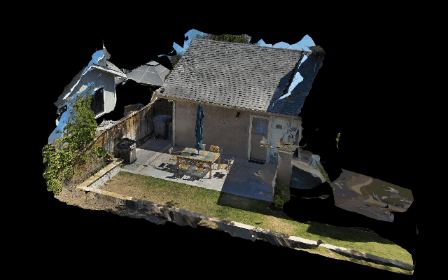With photogrammetry, hundreds of still photos can be transformed into an incredibly realistic 3D model of a real place on Earth — assuming you capture them all.
This Memorial Day weekend, a self-flying robot cameraman did that entire job for me. I simply designated where to fly and where not to fly, kicked back in a chair, and a Skydio 2 drone nabbed those photos all by itself.

Today, Skydio is launching Skydio 3D Scan, an optional software suite for its self-flying drones that lets them build incredibly detailed models for far more important tasks than my holiday backyard BBQ. We’re talking about scanning bridges that might be in need of structural repair, accident reporting at crash sites, and allowing clients to inspect construction sites from most any angle, anywhere in the world, during and after structures are built.
Those aren’t theoretical, by the way: Skydio says the North Carolina Department of Transportation is using it for bridges; the Boston Police Department for crime and accident scene reconstruction; and, below, you can see an real-life interactive 3D example of a water treatment plant for an upcoming semiconductor facility being built in Chandler, Arizona by Sundt Construction, presumably for Intel. (Skydio says it doesn’t know for sure.)
As you can imagine with that kind of clientele, the feature doesn’t come cheap: $2,999 per year, per drone, for the ability to autonomously grab all those photos given a designated volume that you’d like to capture. That also doesn’t include the drone, a controller, or the software you’ll need to actually stitch the images together: $99+ a month for DroneDeploy, or several thousand dollars per year for Bentley Systems’ ContextCapture, as a couple examples — the embedded Sketchfab models in this post use Bentley’s solution. 3D Scan will come to the company’s $10,999-and-up Skydio X2 drone later this summer as well.
Though it’s aimed at professionals with money to spend, a few short sessions showed me you don’t need to be a pro to use 3D Scan, or necessarily even know how to fly a drone. Assuming you’re following all local drone laws, it’s simply a matter of powering up a standard Skydio 2 drone (with two high-capacity microSD cards) and a Skydio controller, then following a series of prompts on a phone. You fly the drone to the top, bottom, and corners of the area you’d like to capture, pick how much detail you want, and then it does the rest on its own — taking pictures with its 12-megapixel front camera while the drone’s other six eyes and navigation system keep it from crashing.
:no_upscale()/cdn.vox-cdn.com/uploads/chorus_asset/file/22554227/skydio_scan_sean_002.jpg)
Like I wrote in our Skydio 2 review, you can trust this drone not to crash, and the 3D Scan mode adds a geofencing feature that can help you keep it from flying into unwanted areas, too. Frankly, I didn’t feel a pressing need to hang onto the controller during my backyard patio scan, so I left it on a table while I watched. The only thing that confused me was knowing when the scan was done: it turns out you have to land the drone, then leave it powered on to finish processing. Then, it was a matter of uploading a couple gigabytes of photos to DroneDeploy or Bentley and waiting for them to process.
:no_upscale()/cdn.vox-cdn.com/uploads/chorus_asset/file/22554226/skydio_scan_sean_004.jpg)
As you’ll no doubt see in the 3D models (or failing that, YouTube), they’re not quite seamless yet — not something you’d want to explore in virtual reality, for instance. (I tried.) Even though I can make out the exact texture of the cement slab and tiles in my backyard, and the metal carnage in this Swiss cheese of a busted helicopter, here are loads of holes and smudges that photogrammetry is just failing to provide.
Skydio CEO and co-founder Adam Bry admits that 3D isn’t everything, and that some clients will simply use 3D as a guide to all of the individual high-res photos that Skydio also provides. “If you set the closest resolution, you’re talking about something like .5mm per pixel … it’s enough to see fine cracks in concrete, it’s enough to see rust on a bolt, it’s enough to see details of a skid mark on the ground.” And while he says the system works in indoor environments, it’s currently optimized for flying around an object you’d like to capture instead of capturing the world around the drone, like you might for an indoor tour. (Skydio is “fairly active” in pursuing inside-out capture as well.)
Long term, Bry thinks the automated aerial scanning might come in handy for digitizing the world for other reasons, like augmented and virtual reality, but for now it seemed like simple, detailed 3D structure modeling was a problem Skydio could solve. “There are countless examples of the world’s best drone pilots keeping this mental model of the path they’ve flown,” says Bry. Now, scanning may not need to be about flying, or even programming a path on a map. It’s just another app on your phone.
Skydio’s holding a special live webinar at the US Space and Rocket Center today at 9AM PT / 12PM ET to show a bit more of what 3D Scan can do. They’ll be scanning some exhibits inside the center, Bry tells me.